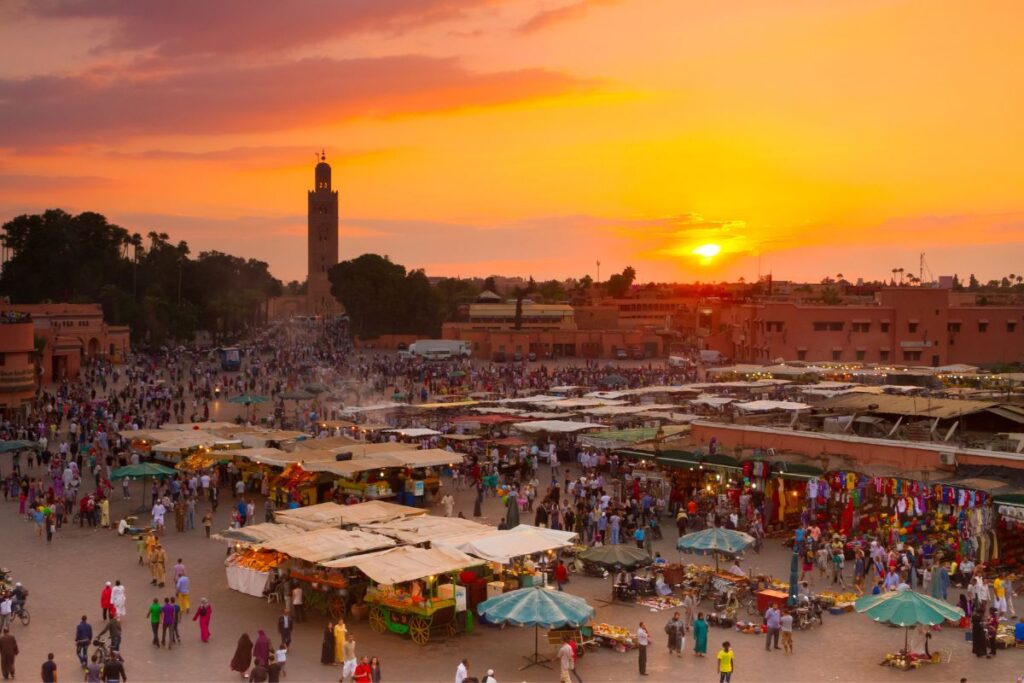
What to do in Marrakech, like the cities of Fes, Rabat, and Meknes, Marrakech has the privilege of being a Makhzen city, that is, imperial, and the successive dynasties that have populated it have been enriching it. It also enjoys a special prestige: that is, it gives its name to the whole country.
Marrakech is cataloged as one of the most important cultural centers in Morocco. It is also the tourist capital, the first destination for trips to Morocco, and an energetic and famous city, among many other things, for its markets and festivals.
Marrakech Legend
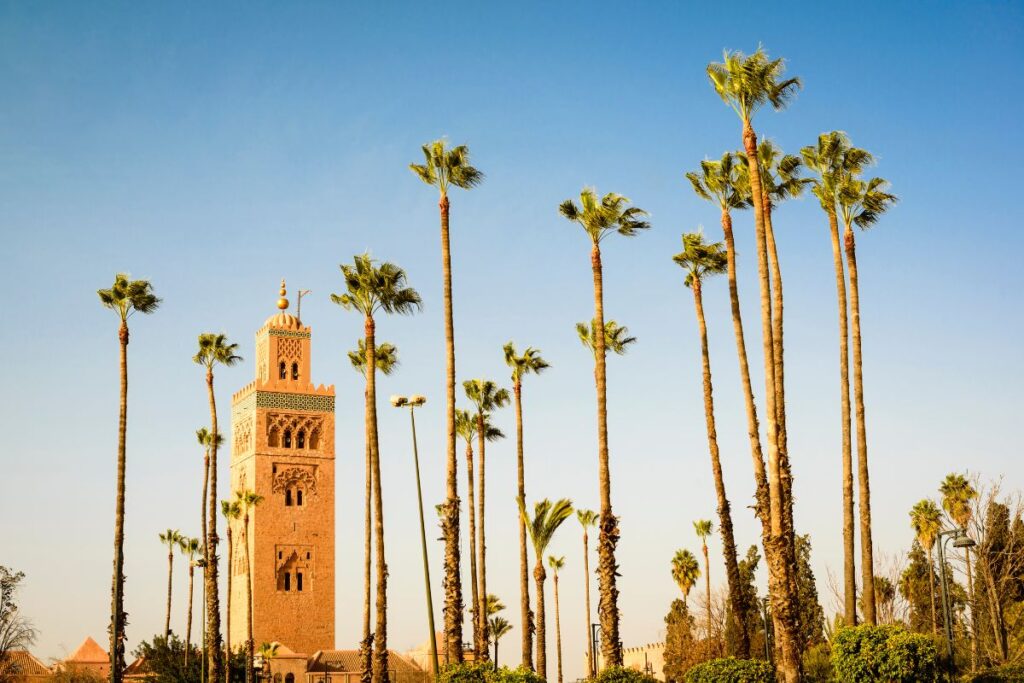
Marrakech Legend has it that when Koutobia was built in the heart of this city, it began to bleed in such a way that it was dyed red, a color that predominates in the city and its surrounding houses, as well as in the national flag of the country. In the following lines, we tell you everything you need to know about this city, such as what to see in Marrakech and some tips on the choice of hotel and flight.
The Origins of the city of Marrakech
The origins of the city of Marrakech are obscure, but it is commonly accepted that it began as a military camp established by Abu Bekr, a great Almoravid chief, in 1070. His cousin and successor, Yusef Ben Tachfin, started converting the primitive oasis into a capital worthy of its empire, which stretched from the Atlantic to Algeria and from the Sahara to the Ebro. The Almohad conquest almost made the first constructions disappear, replaced by others, many of which we still admire today.
Marrakech’s Famous spots & attractions
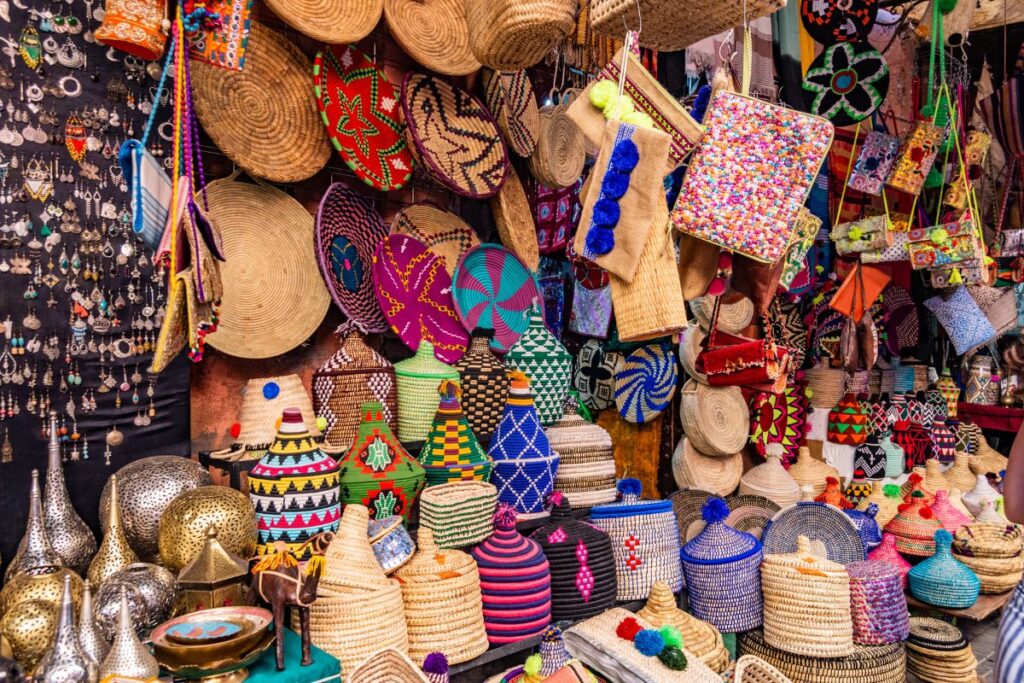
Marrakech, a bustling city in Morocco, boasts several famous spots and attractions. One of the most notable is Djemaa el Fna, also known as Jemaa el-Fna Square, in the city’s heart. This cultural hub has been recognized as a UNESCO World Heritage site. It is known for its vibrant atmosphere and performances by jugglers, storytellers, snake charmers, magicians, acrobats, and other street performers.
Marrakech is also home to some of the best markets, or souks, in the country. These bustling marketplaces offer various goods, including traditional Moroccan crafts, spices, and textiles, and are a favorite destination for tourists worldwide.
When to visit Marrakech
The ideal season to visit Marrakech is during the warmer months. So that the heat does not overwhelm us, the ideal is to do it from September to May. The main cultural festival of the city, which takes place at the beginning of June, can also be an excellent time to visit.
How to get there: train, car, and flights to Marrakech
By plane: The Marrakech International Airport is only 6 km from the city center. In addition to Iberia and Royal Air Maroc, the low-cost airlines Ryanair, EasyJet, and Vueling are also valid for trips to Marrakech.
The best way to get from the airport to the center is by taxi or private transfer. If you travel by taxi, the journey from the airport to the medina is around 80 MAD during the day and about 100 MAD at night. Remember that much of the medina is not passable by vehicle if your accommodation is inside. The taxi can not access it. You will have to leave at some point, and you will have what to do on foot for the rest of the route. The advantage of a private transfer is that they will accompany you to your hotel and you will not have to be haggled as with taxis.
By car: in addition to flights to Marrakech, renting a car and getting to the city by road can also be an option, which gives you more freedom and allows you to know all the towns you find on the road. Of course, you can also get to Morocco in your car, crossing Gibraltar’s Strait. It can be an excellent option if you spend a lot of time in the country because going by your car will not be as expensive as renting one in Morocco.
By train: from Casablanca and other essential cities, the railway lines communicate with Marrakech, and the train leaves you almost in the center of the city (in the new part, not the medina).
How to get around Marrakech
It is a city to walk on foot since its main attractions are in the interior of the medina or ancient city, easily accessible by foot to get around Marrakech and largely forbidden to motor traffic. The problem when visiting Marrakech on foot lies in the labyrinth of its urbanism, so it is essential to get a detailed plan of the medina, which we can get in our hotel.
The new city, built in the 19th century under the French protectorate, is half an hour’s walk from the old city (medina). If you want to move around the new city, you have several options:
Urban buses
You will not find a map with bus stops in Marrakech, so it is best to ask your hotel to see them. The most outstanding are: Jemaa el Fna, the number 11 leading to the airport, and the number 19 company Alsa. The numbers 3, 8 and 10 take you to the train station.
The petit taxi
They are small taxis that, for very little money, will take you to different points of the city. They are helpful if you travel to remote places or a new city. If you have more than three passengers or want to leave the city, take a Grand Taxi.
Horse Cars
The carriages are also economical and an excellent way to travel around Marrakech. To take a horse carriage, you can find them in the section that connects Jemaa el Fnaa with the Mosque of the Koutobia.
What to visit in Marrakech
Marrakech is a city that enjoys strolling and immersing itself in its atmosphere. What to visit in Marrakech depends on when we see it. You can see ‘well’ in two or three days, depending on your rate of visits. We advise you to visit it enjoying its corners if you do not have a lot of time it is not worth trying to see everything because in this way we would be losing the city’s essence. To serve as a reference, these are some important places in the trips to Marrakech:
The Koutoubia Mosque
The Koutoubia Mosque is an icon of the city, the most important and one of the largest in the Muslim West. The minaret of the Koutoubia can be seen almost from anywhere, becoming the city’s central axis. With nearly 70 meters high, it is the tallest building in all of Marrakech. It is forbidden to raise any other that surpasses it.
It was built before the construction of the sanctuary by Abd el Mou and was completed by his little son, Yacoub El Mansour (1184-1189). His name comes from “Kutubiyyun” a souk of books that existed around him. For this reason, it is also known as the Mosque of the booksellers. Non-Muslims are prohibited from entering the mosque of Koutobia, as is the case with all mosques except for a few exceptions.
The Gardens of the Menara
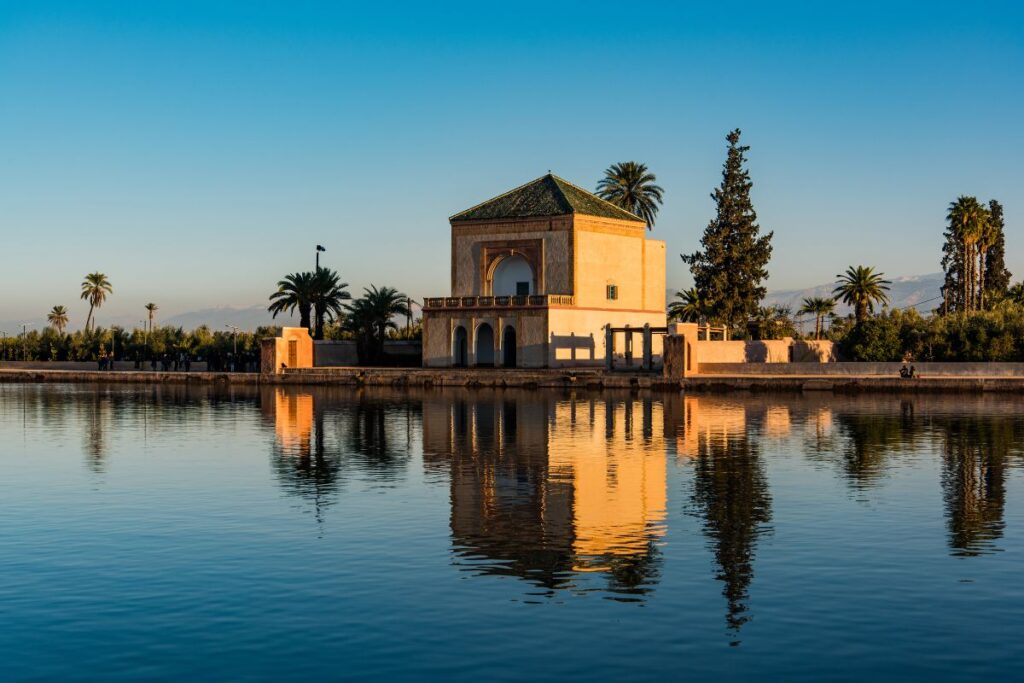
The Gardens of the Menara is one of the best-known and photographed gardens. Next to the garden, we find a beautiful pavilion covered with green tiles, also called Minzah, and it is one of the most beautiful pictures of the city, with the stunning backdrop of the Atlas Mountains covered in snow. These gardens are usually visited by Marrakesh families who come here to spend time with the family and relax in the city’s bustle.
These gardens are located at the southern end, about 45 minutes from the Jemaa el Fna square. They are formed by a large 3 km long and 1.5 km wide enclosure, mainly populated by fruit trees, olive trees, and a huge artificial pond. These gardens were built during the 12th century by the Almohads, who devised a system to bring the water from the Atlas thaw up to here by a series of underground canals to irrigate the olive groves and orchards. It was conditioned (enabled) in the nineteenth by Moulay Abd er Rahman (1922-1859).
The Badi palace
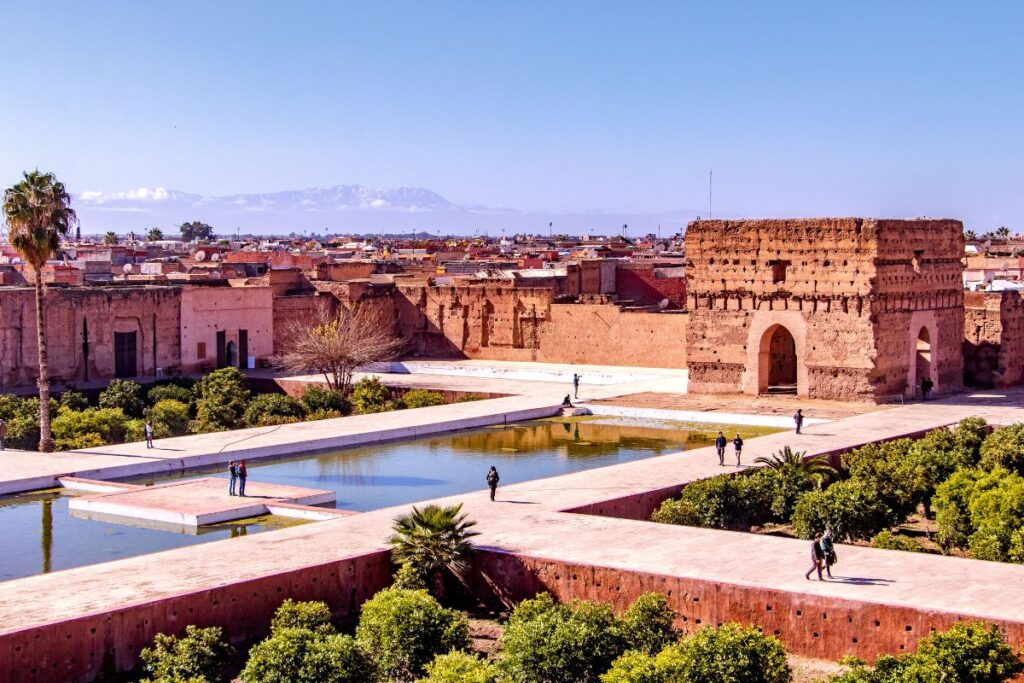
The Badi palace is a few meters from the famous Jemaa el Fna square. Sultan Ahmed al-Mansour built this palace in the late sixteenth century, five months after defeating the Portuguese troops in the famous Battle of the Three Kings on August 4, 1578, with the idea of building the palace more Luxurious and grandiose than ever seen.
Hence the name El Badi which means “The Incomparable”. At the moment, it is practically in ruins being only visitable a large esplanade full of oranges and the building walls from which we can obtain beautiful views of the city and its surroundings, only for all the history that keeps inside and deserves to be included in your list of what to see in Marrakech. The magnificent ruins of this palace served as a framework for the annual festival of Moroccan folklore.
The Saadies Tombs
The Saadies Tombs is one of the most visited monuments in the Kasbah neighborhood. They were built by Sultan Ahmad al-Mansur, the creator of El Badi Palace, during the sixteenth century, but they were not discovered until 1917 after some air flights by Frenchmen. It is one of the few remaining vestiges of the Saadies who ruled the city during its golden age, including 1524 to 1659. These tombs are surrounded by a high wall that isolates La Kasbah from the mausoleums. We can also see a beautiful garden with colorful mosaics decorating over 100 tombs.
Médersa Ben Youssef
Médersa Ben Youssef is located next to a mosque that bears the same name and is one of the most remarkable and beautiful monuments, also essential in any list of what to see in Marrakech. This school of Koranic theology was founded by the sultan Mérinide Abou el Hassan in the middle of the 14th century, becoming the most important in North Africa.
It was composed of a Koranic university and a residence. This school welcomed more than 900 students from all over the Muslim world. The harmony of the alliance between stucco and mosaics, marble, and cedar wood characterizes its architecture and subtle decoration. The most remarkable thing is its interior patio and the decoration and recreation of the rooms, which will make you feel as if you have traveled in time.
Dar Si Said
Dar Si Said is located near the Bahia Palace and was built in the mid-nineteenth century by order of the vizier Ahmed Ben Moussar and the artisans of the Bahia Palace. This is one of the most beautiful palaces in Marrakech. Today it is the seat of the Museum of Moroccan Arts. Your visit is a fundamental introduction to Moroccan handicrafts because, in addition to appreciating its beautiful architecture and decoration, you can also enjoy masterpieces of Moroccan art such as carpets, pieces of wood, jewelry, textiles, and many other details.
Jemaa el Fna Square
Jemaa el Fna Square is the famous square of Marrakech and its true heart. This square gives us the best sample of its way of life and culture, used equally by locals than tourists. During the day, it is full of orange juice stands, which also offer tangerine and grapefruit juices in autumn and winter.
In the square are all kinds of characters, jugglers, snake charmers, chained and trained monkeys to go out in the photos of tourists, water carriers, and storytellers … At dusk, when hundreds of popular restaurants begin to offer their specialties, the square reaches its apotheosis. To capture its essence, you have to walk through it without haste or enjoy it from any of the terraces of local numbers that border it. It is an Oral and Intangible Heritage of Humanity by Unesco.
The palace of Bahia
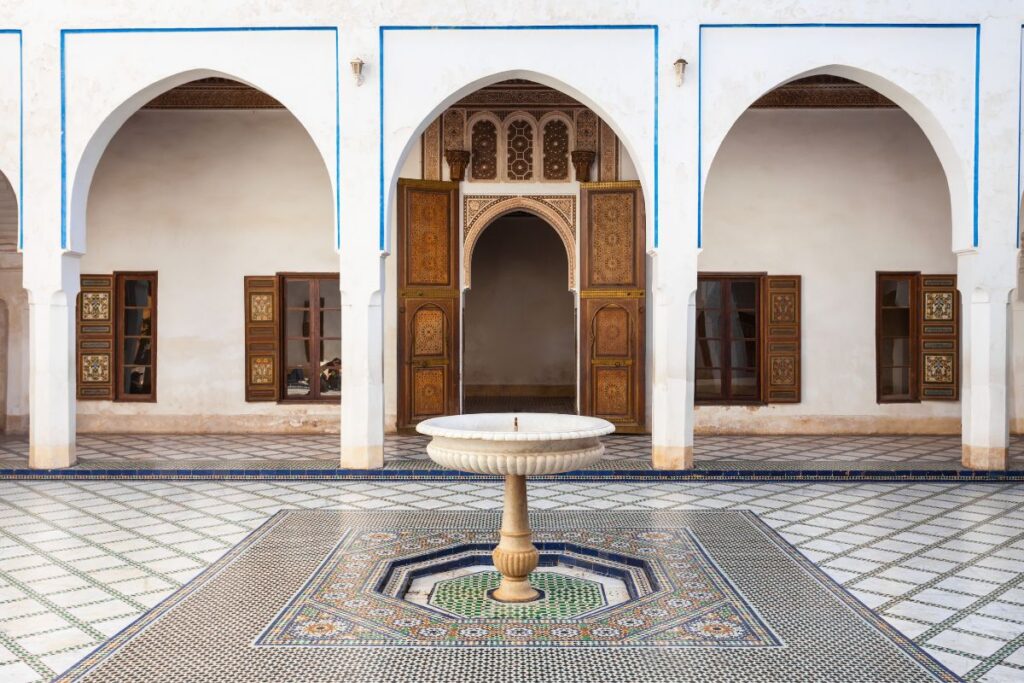
The palace of Bahia is a beautiful palace that is less than a kilometer from the Jemaa el Fna square and is an example of a rich, princely, and realistic dwelling of the late nineteenth century, made by Ahmed ben Moussa, a great vizier of the sultan for his personal use. The design and construction of the palace were the work of the great Moroccan architect Muhammad al-Mekki, who summoned the best artisans for its construction.
It has 160 rooms all arranged on one floor, due to the obesity suffered by the vizier and that prevented him from climbing stairs, with a beautiful garden of 8 hectares. Legend has it that Ahmed ben Moussa dedicated this beautiful palace to his favorite among his harem’s 24 concubines and 4 wives; Bahia Palace means “the beautiful” or “the beautiful”.
The walls
The walls, It is one of the distinctive elements of the city. Built-in adobe and maintained over the centuries, the walls of Marrakech change color tones according to time and daylight. They surround the intricate network of alleyways of the medina, preserving their secrets and closing their nine-door old town.
The Majorelle garden
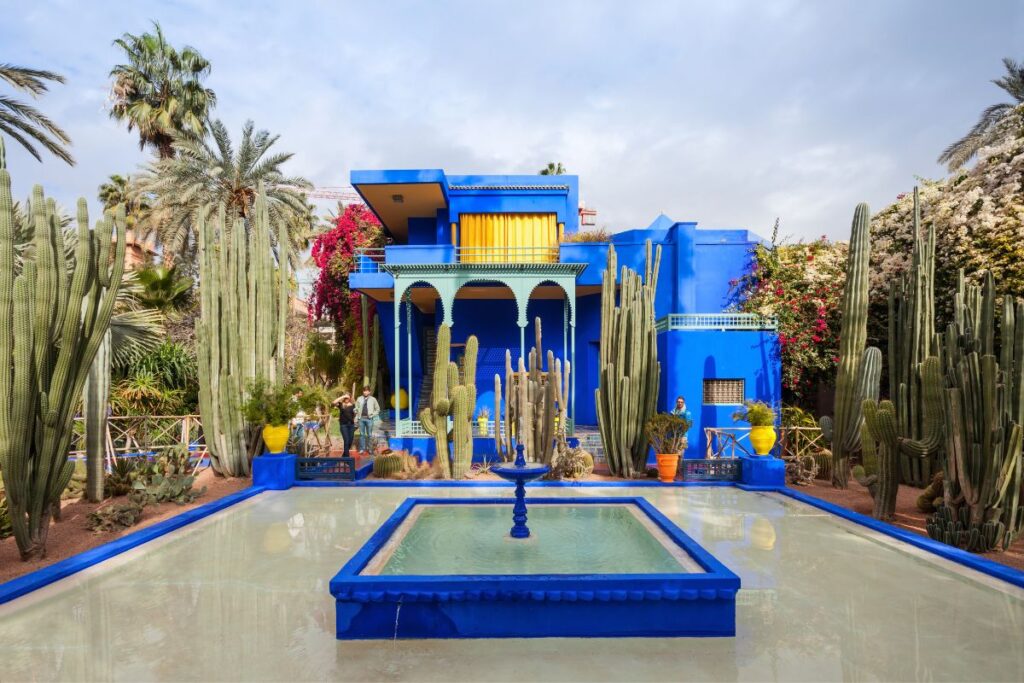
The Majorelle garden is located in the new city, in the Guéliz neighborhood. This beautiful garden was designed by the French painter Jacques Majorelle (now its owner is Yves Saint-Laurent). It is a natural reserve of cactus, bamboo, bougainvillea and many other plants surrounding an art deco style chalet, a cobalt blue color. In addition to this, the gardens are famous for having an extensive collection of birds inside. You will also find a small museum of Islamic art inside the parks. It is an excellent place to rest after the hustle and bustle of the city.
The Mellah of Marrakech or the Jewish quarter
The Mellah of Marrakech, or the Jewish quarter was created in 1559, and until 1936, it was an essential Jewish district in Morocco, reaching a population of 16,000. Since 1956, it is essentially Muslims who live there today.
Currently, it is said that just over 300 Jews are living in the city, and they do it mainly in Guéliz. Mellah is the name by which the Jewish quarters of Morocco are known, and it is believed that its name comes from some salt mines that existed where the Jewish district of Fez later settled. The Mellah of Marrakech is attached to the Royal Palace, a strategic location that provided security, and was also surrounded by walls with only two doors. Through them, they accessed the medina and were guarded by soldiers, which closed at night and only opened the following day.
Koubba Ba’Adiyn
Koubba Ba’Adiyn, Also called Qubba Ba’Adiyn or Koubba Almoravid, is a small dome-shaped building recently restored, dating from the early twelfth century and was built by the second Almoravid king, Ali Ben Youssef. It has the value of being the only example of Almoravid architecture in Morocco and the founder of Marrakech. Also, it has the added value of being a sample of the advanced techniques used by the Almoravids to supply the city with water. Because the ground level has increased in the city over the years, we must go down some stairs to access it.
Other exciting places to see in Marrakech
The ski resorts of Ouikameden and the Ourika Valley are also nearby.
The Royal Palace, Dar el Makhzen, of the foundation Almohad, was extended and embellished under each dynasty. King Hassan II restored it at the beginning of the 60s.
If the trip coincides with June, you must attend the National Folklore Festival, which brings together the best expressions of music, singing, and popular dance in Marrakech.
As a tourist capital, it offers exceptional accommodations.
A famous Marrakech hotel is La Mamounia. But there are also campsites and youth hostels, luxurious restaurants of Moroccan specialties with folkloric and fantasy shows, and even French, Italian, Jewish, and international cuisine. Nightclubs, casinos, and party halls complete the offer of nightlife.
The city is also the starting point for numerous excursions of significant architectural, cultural, and scenic interest. Los Palmerales, the routes of the High Atlas, and innumerable towns such as Tameslouht, Amizmiz, or Asni offer varied possibilities of enjoyment to the curious traveler.
Travel to Marrakech
We can help you prepare and make your trip to Marrakech with everything included since you set foot in the country. Contact us and we will help you choose the customized trip or circuit that best suits you, monumental, archaeological, nature, escapades, or beaches. Travel-oriented to all tastes and styles. Live in Morocco in its entirety and marvel at the country’s beauties. Quality Marrakech trips from the hands of professionals at the best price.
Excursions around Marrakech
Marrakech is fortunate to be surrounded by a diverse range of unique destinations perfect for day trips. Visitors can easily explore the surrounding areas and see all the amazing attractions nearby. Some of the most popular and must-visit excursions from Marrakech include:
Excursion from Marrakech to the Ourika Valley
One of the most popular excursions from Marrakech is a visit to the green Ourika Valley, just one hour away. This picturesque valley is dominated by the impressive Toubkal mountain, which stands at the height of 4,167 meters. Visitors can take in the stunning views of the peaks and valleys of the Great Atlas while exploring the deep hidden valleys, ancient villages, and mighty mountain rivers in the area. It’s also an excellent opportunity to observe the daily lives of the local population.
Excursion from Marrakech to Essaouira
One-day round trip excursion to the old Portuguese city of Essaouira from Marrakech. During the journey, we’ll pass through vast forests of Argan, where the valuable Argan oil is extracted, and visit some of the cooperatives to see how it’s made. Essaouira is an ancient Portuguese fortress with many charming spots and historical sites to explore. It’s a perfect day trip to enjoy the beach and explore the city’s rich culture and history.
Excursion from Marrakech to Ouarzazate and Ait Ben Haddou
Ouarzazate and Ait Ben Haddou Excursion from Marrakech Embark on a roundtrip excursion from Marrakech to Ouarzazate and Ait Ben Haddou in just one day. Journey through Tiz’n Tichka, a mountain pass in the Atlas range, and marvel at the incredible landscapes and beautiful Kasbahs or fortified cities that crown the Tichka port. Explore Ouarzazate and visit the famous Ait Ben Haddou, an ancient fortified city, and a UNESCO World Heritage Site featured in many favorite movies and TV shows.
Excursion from Marrakech to the Ouzoud Waterfalls
One of the best day trips to experience the beauty of nature near Marrakech is to visit the stunning Ouzoud Waterfalls. The waterfalls feature cascading waters that can reach up to 60 meters. It’s considered the largest and most impressive waterfall in North Africa and a perfect destination for those who love nature and want to see this natural wonder up close.
Excursion from Marrakech to Asni and Valle of Imlil
Starting in the morning, we head towards the majestic Atlas Mountains. At the foot of the Toubkal, the highest peak in Morocco and North Africa, we pass through the small village of Tahanaout, which hosts a weekly farmer’s market on Tuesdays and Saturdays. Continuing, we visit the Ghaghia Wadi Gorges before arriving in Asni, known as the country of amethysts, and the beautiful green valley of Ouirgane also called the Valley of Happiness.
Where to eat
Undoubtedly, in this city, it is best to eat at the multiple stands in the Djema.el-Fna square. Quality, variety, and economical prices. The fun is to jump from post to post and try a bit of everything. At the end of the afternoon, this square looks like a smoky industry where the most varied aromas come from. You can complete your diet with splendid natural orange juice.
Riad Tamsna Restaurant: It is located at number 23 of Derb Zanka Daika, in the Palmeraie area. It is a restaurant with a jazz atmosphere, tranquil and with international food, being its specialty is Maghrebi cuisine. It is a somewhat expensive restaurant, but it is worth visiting. Remember that wine is always included, so you must indicate it before if you do not want it.
Palais Jad Mahal: It is one of the fashionable restaurants in the Fontaine de la Mamounia, in the Bab Jdid area. It is economical to compare it with other restaurants of its category, with international cuisine, highlighting India among them.
Chez Chegrouni: It is an economical restaurant in Jemaa-el-Fna with a delicious terrace that will make you enjoy the food and night vision of the hustle and bustle of the most crucial square in Morocco.
Café de France: We recommend it especially. One of the most renowned cafés in Marrakech, also located in Jemaa-el-Fna and with a terrace in the square itself, will make you enjoy at night the most authentic and bohemian atmosphere, enjoying a coffee or tea.
Jemma-el-Fna Restaurant: Located in the square of the same name, it is an authentic and popular restaurant, so hygiene is not your best asset, but its dishes are traditional and popular. In this restaurant, there are no cutlery or plates (yes, there are if you ask them, but we do not recommend them), so you’ll have to eat with your hands and help yourself with the bread. Quite an experience
Pizzeria Venezia: If one day you want to escape from the traditional cuisine and its spicy dishes, an economical option is this pizzeria located on Avenue Mohammed V. It has a terrace in front of the Koutoubia Mosque and offers a wide variety of pizzas and salads very well prepared.
Dar Marjana – Telephone: 445773. Opposite the palace of the Glaui.
Dar Fez – Phone: 310185. Rue Boussoni.
Dar es Salaam Phone: 423272. In Riad Zitoun el Quedim.
Le Marrakchi Restaurant, 52 Rue des Banques, next to the square. Telephone: 443377. Traditional quality cuisine and dances.
Marrakech Casino, belonging to the Hotel La Mamounia. You can take a menu with a good show of belly dancers between blackjack and roulette games.
Stylia 34 – Address: rue Ksour, Telephone: (044) 440505. Dinner with a fixed menu. Excellent traditional food in a 15th-century house in the middle of the medina.
Trips to Morocco from Marrakech
Suppose you plan to visit Marrakech and want to start your Morocco trip here. In that case, we offer you numerous tours through Morocco departing from the city of Marrakech, with terms that include the main cities and tourist destinations of Morocco, such as the imperial cities, the most beautiful cities of the Atlantic coast country, charming villages, the Sahara desert, arid passages, fortifications and Berber villages, dunes and the most barren lands.
Find the best trips in Morocco and book the circuit that best suits your needs. If the course does not fit your interests or tastes, ask us for your customized trip, request information, and enjoy a journey you will never forget.
Where to sleep: Hotels in Marrakech and other options
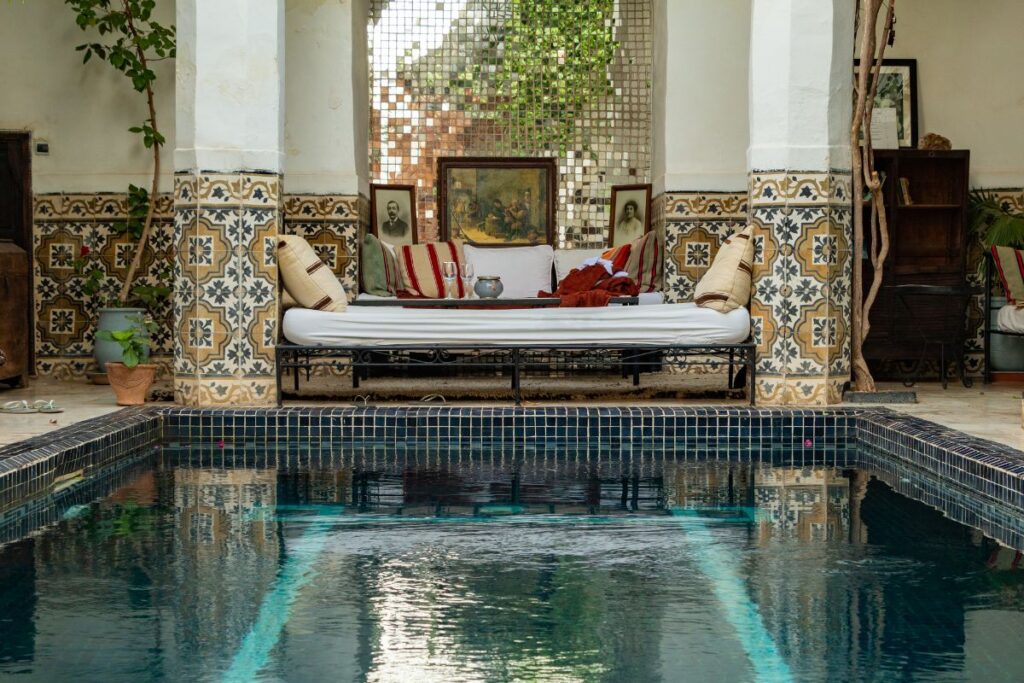
There are different types of accommodation, those that attract most for their decoration, reminiscent of the most refined imperial era, are the riads. The Riad is a house or old palace built around a garden. In Marrakech, a hotel can have very varied prices, some affordable, that facilitate the exploration of the old part of the city.
What are the must-see attractions in Marrakech?
The must-see attractions in Marrakech include Jemaa el-Fnaa square, Koutoubia Mosque, Bahia Palace, Saadian Tombs, Ben Youssef Madrasa, and Majorelle Garden.
What is the best time of year to visit Marrakech?
The best time of year to visit Marrakech is from March to May or from September to November when the weather is pleasant and there are fewer tourists.
What are the top things to do in Marrakech for families with children?
For families with children, some top things to do in Marrakech include visiting the Majorelle Garden, taking a hot air balloon ride, or exploring the medina on a horse-drawn carriage.
Where can I find the best shopping in Marrakech?
The best shopping in Marrakech can be found in the medina souks, where you can find a wide range of traditional Moroccan crafts, including textiles, pottery, and jewelry.
Is walking around the medina (old town) in Marrakech safe?
Walking around the medina in Marrakech is generally safe, but visitors should be cautious of pickpockets and be mindful of their belongings.
What is the best way to get around Marrakech?
The best way to get around Marrakech is by walking or taxi, although visitors should be prepared to negotiate prices.
Where can I find the best street food in Marrakech?
The best street food in Marrakech can be found in Jemaa el-Fnaa square, where visitors can try traditional dishes such as tagine or harira soup.
What are the top cultural experiences to have in Marrakech?
Some top cultural experiences in Marrakech include taking a cooking class, visiting a traditional Moroccan riad, or attending a Moroccan music or dance performance.
Are there any local festivals or events worth attending in Marrakech?
Some local festivals or events worth attending in Marrakech include the Marrakech International Film Festival and the Marrakech Biennale.
What is the nightlife like in Marrakech?
Marrakech has a vibrant nightlife scene with many bars, clubs, and restaurants open late into the night, particularly in the Gueliz and Hivernage neighborhoods.

